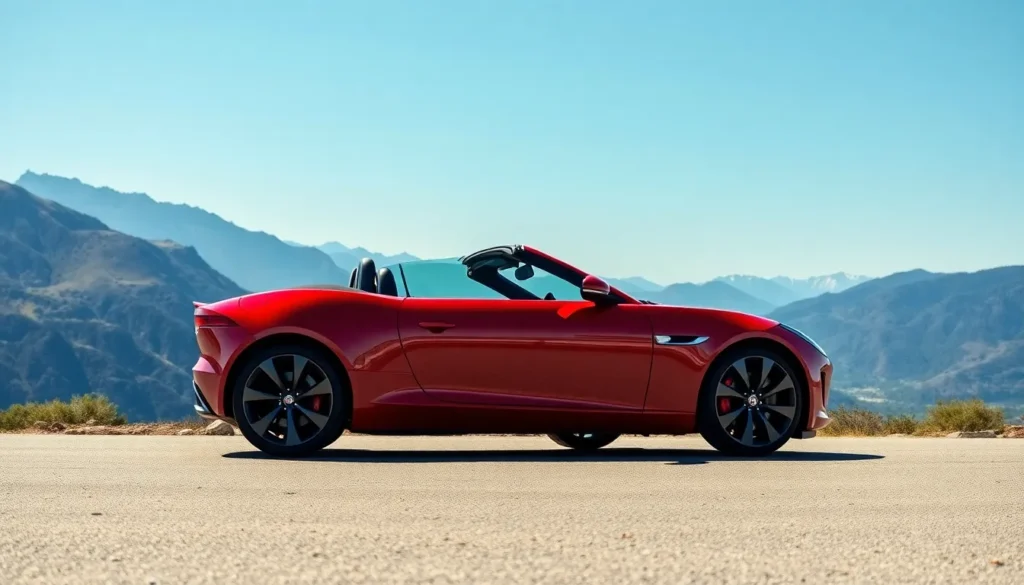When we think about automotive excellence meeting raw performance the Jaguar F-Type immediately springs to mind. This British sports car has captivated driving enthusiasts worldwide since its debut transforming the luxury sports car industry with its stunning design and heart-pounding performance capabilities.
We’ve witnessed countless sports cars come and go but the F-Type stands apart with its distinctive growling exhaust note sleek silhouette and race-inspired engineering. Whether you’re considering the coupe or convertible model this Jaguar delivers an intoxicating blend of style sophistication and speed that few competitors can match.
From its aluminum-intensive construction to its meticulously crafted interior the F-Type represents everything we love about British automotive craftsmanship. In this comprehensive guide we’ll explore what makes this sports car so special and why it continues to turn heads on roads everywhere.
Jaguar F-Type Overview and Design Philosophy
The Jaguar F-Type represents our modern interpretation of the classic British sports car lineage that dates back to the legendary E-Type of the 1960s. Sleek proportions and muscular stance define this two-seat sports car that launched in 2013 as Jaguar’s flagship performance vehicle. We observe how the F-Type’s design philosophy centers on emotional engagement rather than mere transportation.
Long hood and short rear deck create the quintessential sports car silhouette that immediately commands attention. Distinctive LED daytime running lights form a J-blade signature that became synonymous with modern Jaguar design language across the entire model range. Our analysis reveals how these visual elements work together to create what Jaguar calls “fast beautiful” design.
Aluminum intensive construction forms the foundation of the F-Type’s lightweight architecture, utilizing the same premium space frame technology found in high-end supercars. This construction method reduces overall weight by approximately 40% compared to traditional steel construction while increasing structural rigidity by 30%. Performance benefits include improved acceleration, handling precision, and fuel efficiency across all F-Type variants.
| Design Element | Specification | Impact |
|---|---|---|
| Aluminum Body Construction | 95% aluminum content | 40% weight reduction |
| Wheelbase | 103.2 inches | Optimal balance |
| Overall Length | 164.4 inches (Coupe) | Compact sports car proportions |
| Track Width | 63.4 inches (front) | Enhanced stability |
| Ground Clearance | 4.7 inches | Low center of gravity |
British craftsmanship influences every detail from the hand-stitched leather interior to the precisely engineered mechanical components. We recognize how Jaguar’s design team drew inspiration from aviation and yacht design to create flowing surfaces that appear to move even when stationary. Each curve serves both aesthetic and aerodynamic purposes, contributing to the F-Type’s impressive drag coefficient of 0.33.
Interior design philosophy emphasizes driver focus through a cockpit layout that positions all controls within easy reach. Premium materials including Windsor leather, aluminum trim, and soft-touch surfaces create an environment that matches the exterior’s emotional appeal. Digital instrument cluster and infotainment system blend seamlessly with traditional analog gauges to balance modern technology with classic sports car character.
Exterior Design and Styling
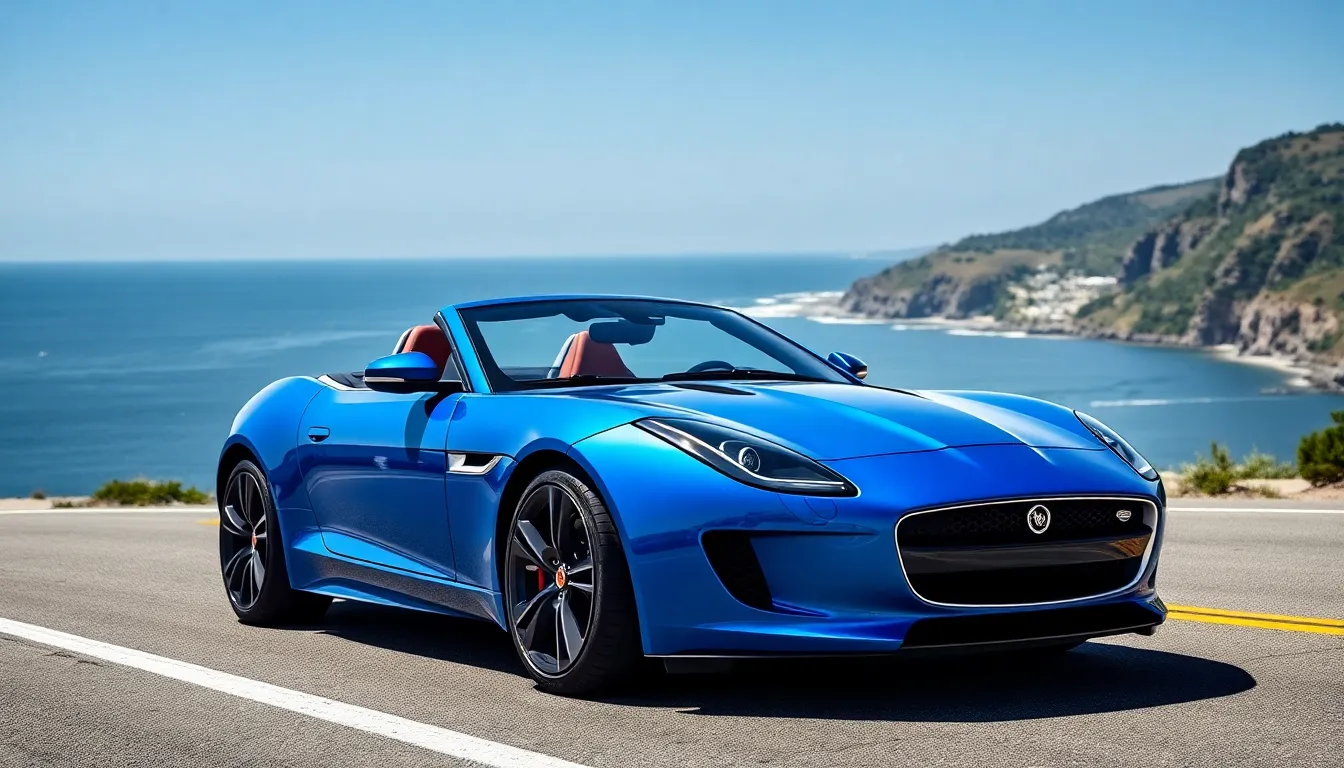
The Jaguar F-Type’s exterior design represents a masterful blend of classic British sports car heritage and contemporary automotive artistry. Every curve and contour serves both aesthetic and functional purposes in creating this stunning performance machine.
Distinctive Jaguar DNA
The F-Type embodies quintessential Jaguar design elements that trace back 60 years to the iconic E-Type. Signature features include the distinctive clamshell hood that creates a long, muscular bonnet line stretching toward the prominent front grille. The side profile showcases classic proportions with a long hood, short rear deck, and low-slung stance that measures just 51.4 inches in height.
J-blade LED daytime running lights serve as the F-Type’s most recognizable design signature, creating a bold visual statement while providing enhanced visibility. These distinctive light elements integrate seamlessly into the front bumper design and have become synonymous with modern Jaguar styling across the brand’s lineup.
The rear haunches flow gracefully from the doors, creating pronounced wheel arches that house wheels ranging from 18 to 20 inches in diameter. Body proportions emphasize the rear-wheel-drive architecture with a wide 62.1-inch rear track that enhances the car’s planted appearance. Chrome accents highlight key design elements including window surrounds, grille mesh, and side vents without overwhelming the clean aesthetic.
Aerodynamic Performance Features
Active aerodynamics optimize the F-Type’s performance through sophisticated airflow management systems. The front splitter directs air beneath the vehicle while side vents extract hot air from the engine bay and reduce pressure buildup around the front wheels. These functional elements contribute to a drag coefficient of 0.33 for coupe models.
Rear spoiler deployment occurs automatically at speeds exceeding 70 mph, extending 60mm to provide additional downforce and stability. The system retracts when speeds drop below 50 mph, maintaining the clean rear profile during normal driving conditions. Carbon fiber construction reduces weight while providing optimal strength for high-speed aerodynamic loads.
Underbody panels create a smooth airflow path from front to rear, reducing turbulence and drag while managing cooling requirements. Side gill vents behind the front wheels not only pay homage to classic Jaguar design but actively improve aerodynamic efficiency by venting hot air from the brake systems and wheel wells.
The convertible model features additional aerodynamic considerations including wind deflector systems that minimize cabin turbulence at highway speeds. These elements integrate invisibly into the design while providing measurable improvements to passenger comfort and vehicle stability.
Interior Quality and Technology
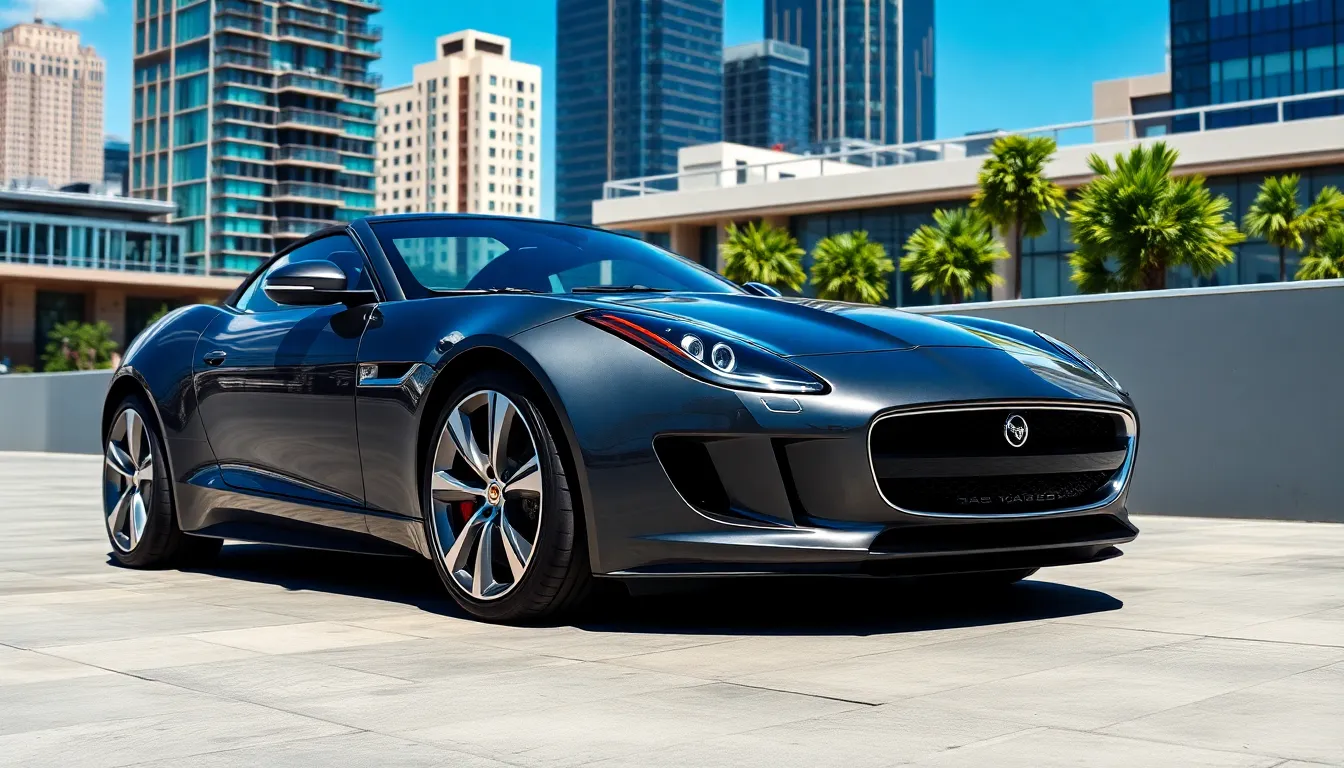
The Jaguar F-Type’s interior elevates luxury sports car standards through premium materials and cutting-edge technology integration. British craftsmanship meets modern innovation in a driver-focused cockpit designed for both performance and comfort.
Cabin Materials and Craftsmanship
Premium leather upholstery defines the F-Type’s interior with hand-stitched details and contrast piping available in multiple color combinations. We find Windsor leather as standard equipment with optional semi-aniline leather featuring diamond-quilted patterns on higher trim levels. Aluminum trim pieces complement the leather surfaces with brushed or anodized finishes depending on the selected interior package.
Jaguar’s attention to detail extends to the instrument panel construction featuring soft-touch materials and precision-fitted panels. The seats incorporate memory foam cushioning with 18-way power adjustment capabilities including lumbar support and side bolster adjustment. Carbon fiber trim replaces aluminum on R-Ever-changing and SVR variants creating a more performance-oriented aesthetic.
Climate-controlled seats provide heating and cooling functions through perforated leather surfaces. We observe precise stitching patterns throughout the cabin including the dashboard, door panels, and center console areas. The gear selector rises from the center console when the engine starts, demonstrating the theatrical engineering touches that define the F-Type experience.
Infotainment and Driver Assistance Systems
The Touch Pro infotainment system operates through a 10-inch touchscreen display with smartphone integration including Apple CarPlay and Android Auto compatibility. We access navigation, audio controls, and vehicle settings through intuitive menu structures with customizable home screen layouts. The system processes voice commands for hands-free operation of climate control, phone functions, and media selection.
Premium audio comes from a 770-watt Meridian sound system featuring 11 speakers strategically positioned throughout the cabin. Digital instrument clusters display performance data including g-force readings, lap timer functions, and engine parameters through configurable 12.3-inch TFT screens. Track driving modes alter the display layouts to prioritize performance metrics over standard vehicle information.
Driver assistance features include adaptive cruise control with queue assist, blind spot monitoring with closing vehicle sensing, and lane keep assist with driver condition monitoring. Emergency braking systems activate automatically when forward collision risk reaches critical thresholds. Parking assistance includes rear traffic monitor, 360-degree camera systems, and park assist with automated steering inputs for parallel and perpendicular parking maneuvers.
Engine Options and Performance
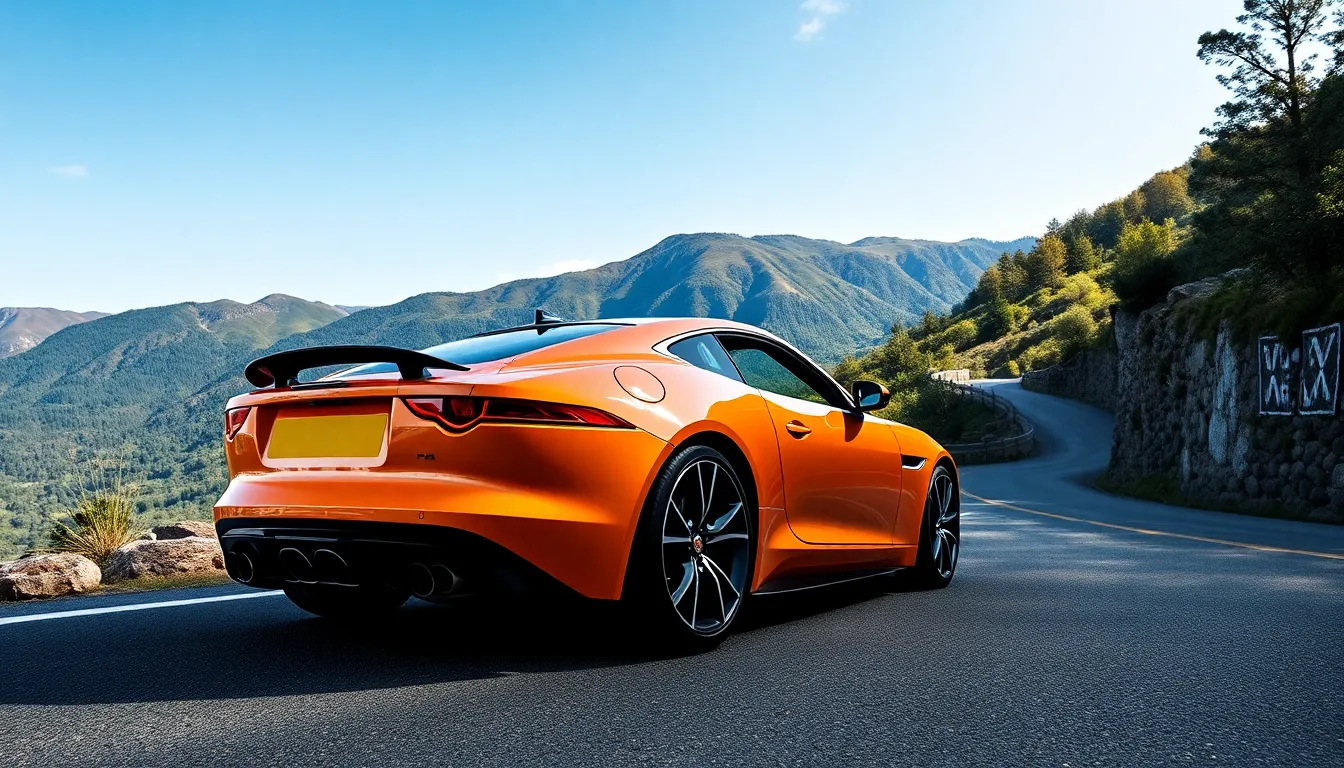
The Jaguar F-Type delivers exceptional performance through carefully engineered powertrains that embody British automotive excellence. Each engine configuration transforms the driving experience with distinct characteristics and capabilities.
V6 and V8 Powertrain Choices
Our F-Type lineup features three distinct engine configurations that cater to different performance preferences. The base 2.0-liter turbocharged four-cylinder produces 296 horsepower and 295 lb-ft of torque, accelerating from 0-60 mph in 5.4 seconds. Moving up the range, the 3.0-liter supercharged V6 generates 380 horsepower and 339 lb-ft of torque, reducing the 0-60 mph time to 4.9 seconds.
The flagship 5.0-liter supercharged V8 represents the pinnacle of F-Type performance, delivering 575 horsepower and 516 lb-ft of torque in the SVR variant. This powerhouse catapults the F-Type from standstill to 60 mph in just 3.5 seconds, reaching a top speed of 200 mph. Each engine pairs with an eight-speed automatic transmission that features paddle shifters for manual control.
| Engine Type | Horsepower | Torque (lb-ft) | 0-60 mph (seconds) | Top Speed (mph) |
|---|---|---|---|---|
| 2.0L Turbo I4 | 296 | 295 | 5.4 | 155 |
| 3.0L Supercharged V6 | 380 | 339 | 4.9 | 171 |
| 5.0L Supercharged V8 | 575 | 516 | 3.5 | 200 |
All-wheel drive comes standard on V8 models and remains available as an option on V6 variants, improving traction and stability across various driving conditions.
Handling and Driving Dynamics
Advanced suspension technology forms the foundation of the F-Type’s exceptional handling characteristics. Double-wishbone front suspension and multi-link rear suspension provide precise wheel control during spirited driving. Adaptive dampers continuously adjust compression and rebound rates based on driving conditions and selected driving modes.
Electronic systems work harmoniously to optimize performance delivery. Ever-changing Stability Control monitors vehicle behavior 100 times per second, making instantaneous corrections to maintain optimal grip. Torque Vectoring by Braking applies selective braking to individual wheels during cornering, reducing understeer and improving agility.
The configurable driving modes transform the F-Type’s personality at the touch of a button. Rain/Ice/Snow mode prioritizes safety and traction, while Ever-changing mode sharpens throttle response, steering feel, and suspension settings. Track mode unleashes maximum performance potential by optimizing all systems for circuit driving.
Brembo brakes provide exceptional stopping power across the range. Front brake discs measure 380mm on V8 models, while carbon-ceramic brakes offer fade-resistant performance for track enthusiasts. Electronic Brake Assist detects emergency braking situations and applies maximum stopping force when needed.
Weight distribution achieves a near-perfect 50:50 balance through strategic component placement, including mounting the battery in the trunk and positioning the engine behind the front axle centerline. This configuration enhances cornering stability and provides neutral handling characteristics that inspire confidence at any speed.
Practicality and Daily Usability
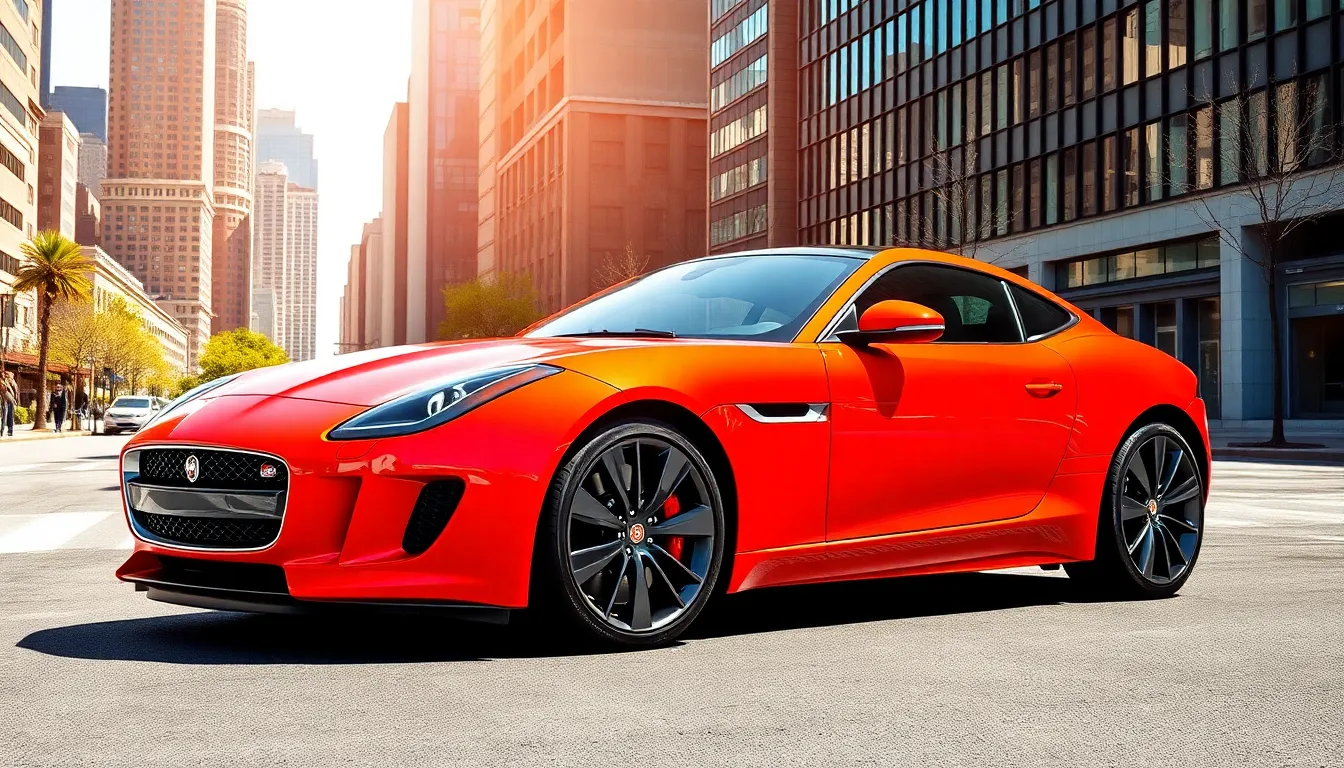
The Jaguar F-Type transforms from weekend sports car into a surprisingly practical daily companion. Real-industry usability extends beyond its stunning performance credentials to cover everyday driving considerations.
Storage Space and Comfort
Cargo capacity in the F-Type coupe measures 11 cubic feet, while convertible models offer 7.1 cubic feet with the soft top raised. Behind the seats, additional storage compartments accommodate smaller items like smartphones and wallets. The center console features dual cupholders and a storage bin suitable for sunglasses or parking passes.
Seating comfort prioritizes driver engagement over passenger accommodation. Both front seats provide excellent support during spirited driving, with 14-way power adjustment standard across all trim levels. Taller drivers measuring 6’2″ or above may find headroom limited in coupe variants. The cabin width measures 55.7 inches, creating a cozy but intimate environment that some drivers find restrictive during extended journeys.
Entry and exit requires careful maneuvering due to the low ride height and wide door sills. The doors open to 90 degrees, providing adequate access even though the sports car’s low stance. Passengers over 60 years old often report difficulty entering and exiting gracefully, particularly in convertible models.
Daily driving position places controls within easy reach, though the infotainment system requires taking eyes off the road for menu navigation. Climate controls remain physical buttons, ensuring quick adjustments without touchscreen interaction.
Fuel Economy Considerations
EPA ratings for the F-Type vary significantly across engine variants. The turbocharged four-cylinder achieves 23 mpg city and 30 mpg highway, making it the most efficient option for daily commuting. V6 models deliver 20 mpg city and 28 mpg highway, while the supercharged V8 manages just 15 mpg city and 23 mpg highway.
Real industry fuel consumption typically falls 2-3 mpg below EPA estimates during aggressive driving. Highway cruising at 75 mph returns approximately 26 mpg in four-cylinder models and 22 mpg in V6 variants. City driving with frequent acceleration drops fuel economy to 18 mpg for base engines and 12 mpg for V8 powertrains.
Fuel tank capacity measures 15.6 gallons across all F-Type variants, providing a driving range between 234 miles (V8) and 390 miles (four-cylinder) depending on engine choice and driving style. Premium unleaded gasoline remains mandatory for all engines, adding approximately $0.30 per gallon to fuel costs compared to regular gasoline.
Annual fuel costs average $2,400 for four-cylinder models, $2,800 for V6 variants, and $3,600 for V8 versions based on 12,000 miles of mixed driving and current premium fuel prices.
Safety Ratings and Reliability
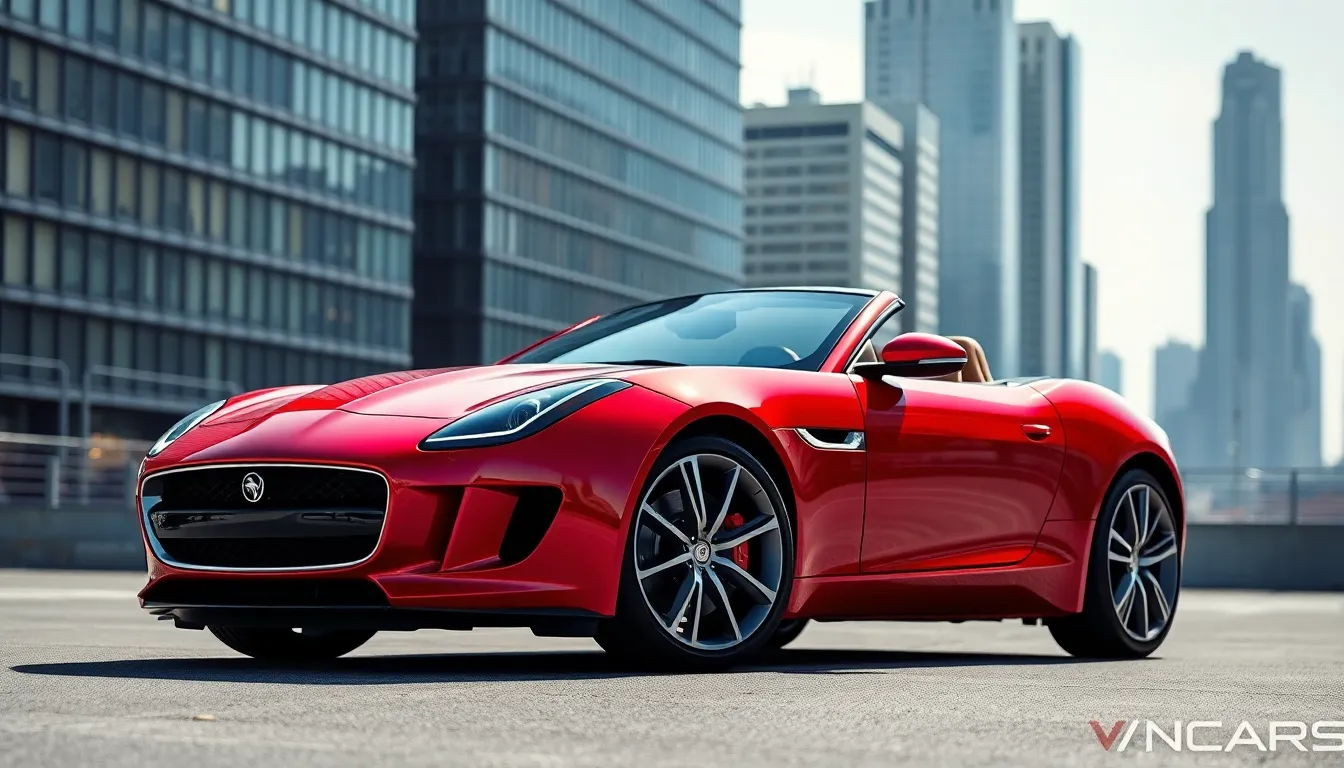
Jaguar F-Type safety ratings reflect the manufacturer’s commitment to comprehensive protection systems across all variants. We recognize the importance of examining both crash test performance and real-industry reliability data when evaluating this luxury sports car’s safety credentials.
Crash Test Performance
The F-Type earned a 5-star Euro NCAP overall safety rating, demonstrating exceptional performance across multiple test categories. Adult occupant protection scored 90%, while child occupant protection achieved 79% in standardized testing scenarios. Safety assist systems contributed an 81% score, highlighting the effectiveness of advanced driver assistance technologies.
IIHS testing revealed Top Safety Pick recognition for the F-Type, with Good ratings in most crash scenarios. The moderate overlap front test, side impact assessment, and roof strength evaluation all received the highest possible scores. Small overlap front testing achieved an Acceptable rating, indicating room for improvement in this exact crash scenario.
| Safety Test Category | F-Type Rating | Score Percentage |
|---|---|---|
| Euro NCAP Overall | 5 Stars | 90% |
| Adult Occupant Protection | Excellent | 90% |
| Child Occupant Protection | Good | 79% |
| Safety Assist | Very Good | 81% |
| IIHS Top Safety Pick | Yes | Good/Acceptable |
Active Safety Features
Advanced driver assistance systems form the foundation of F-Type’s active safety approach. Autonomous emergency braking engages automatically when forward collision risk increases, operating effectively at speeds up to 50 mph in urban environments. Blind spot monitoring alerts drivers to vehicles in adjacent lanes through visual and audible warnings.
Lane keep assist technology provides gentle steering corrections when unintentional lane departures occur. Traffic sign recognition reads speed limit signs and displays current restrictions on the digital instrument cluster. Rear cross traffic alert warns drivers of approaching vehicles when reversing from parking spaces.
Driver condition monitoring analyzes steering patterns and suggests rest breaks during extended driving sessions. These systems work together to create multiple layers of protection, reducing accident probability through proactive intervention.
Build Quality and Reliability Metrics
Jaguar F-Type reliability scores demonstrate above-average performance compared to luxury sports car competitors. J.D. Power reliability ratings placed the F-Type in the top tier of premium sports cars, with an overall dependability score of 83 out of 100 points.
Common maintenance requirements include regular oil changes every 10,000 miles and brake inspections every 20,000 miles. Warranty coverage extends to 5 years or 60,000 miles for comprehensive protection, with powertrain coverage lasting 5 years or 60,000 miles.
Electronic system reliability proves particularly strong, with infotainment and driver assistance features showing minimal failure rates. Mechanical components like suspension bushings and brake pads represent typical wear items requiring replacement between 30,000 to 50,000 miles depending on driving conditions.
Structural Integrity
The F-Type’s aluminum intensive architecture contributes significantly to occupant safety through advanced energy absorption characteristics. Crumple zones are engineered to manage impact forces effectively while maintaining cabin integrity during collisions. High strength steel reinforcements in critical areas provide additional protection without compromising the lightweight construction benefits.
Side impact protection utilizes reinforced door frames and strategically placed aluminum beams to distribute crash energy away from occupants. The convertible model includes additional structural reinforcements to compensate for the absence of a fixed roof, maintaining similar safety standards as the coupe variant.
Roll bars deploy automatically in convertible models when sensors detect an imminent rollover scenario, providing crucial head protection within 150 milliseconds of activation.
Pricing and Value Proposition
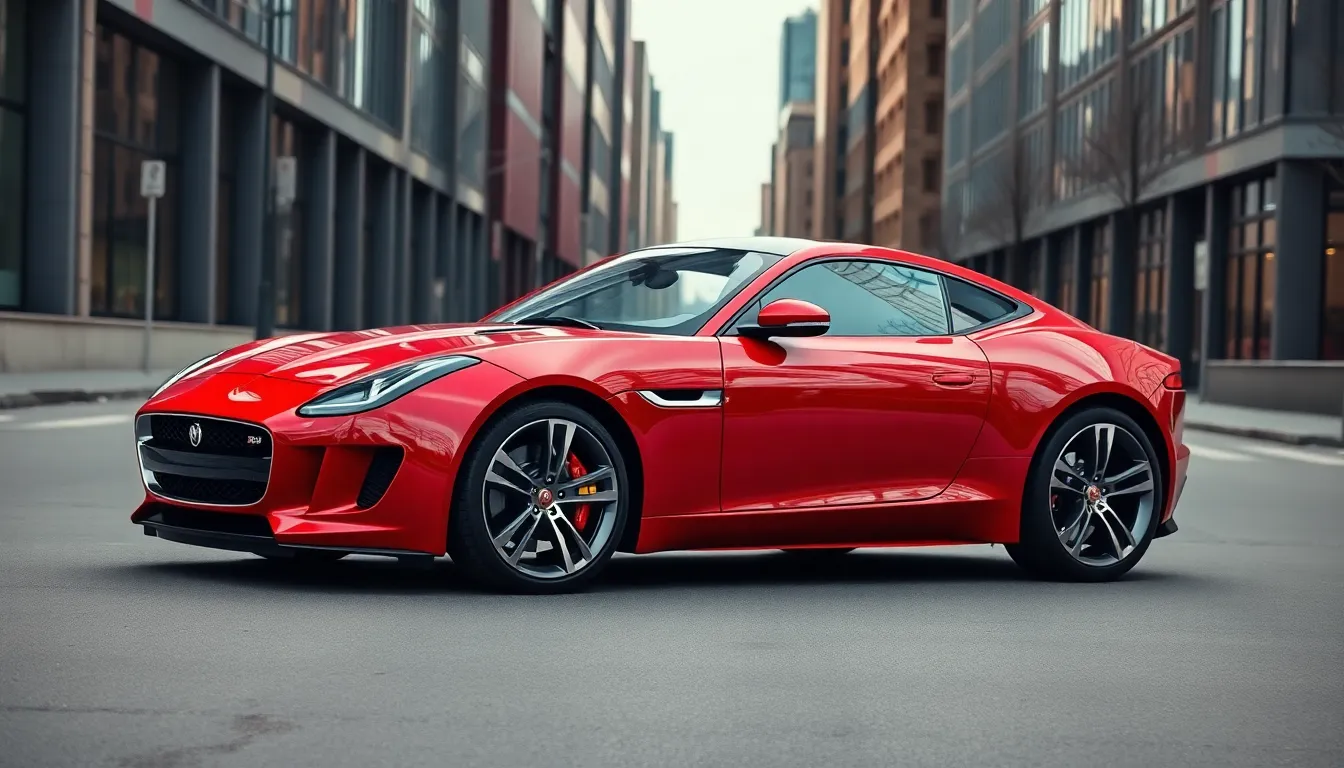
Jaguar F-Type pricing starts at $73,400 for the base P300 coupe with the 2.0-liter turbocharged four-cylinder engine. Mid-range P380 models equipped with the 3.0-liter supercharged V6 carry an MSRP of $85,900 for coupes and $88,400 for convertibles. Performance-focused P575 variants featuring the 5.0-liter supercharged V8 command $108,500 for coupes and $111,000 for convertibles.
| F-Type Variant | Engine | Body Style | Starting MSRP |
|---|---|---|---|
| P300 | 2.0L Turbo I4 | Coupe | $73,400 |
| P380 | 3.0L Supercharged V6 | Coupe | $85,900 |
| P380 | 3.0L Supercharged V6 | Convertible | $88,400 |
| P575 | 5.0L Supercharged V8 | Coupe | $108,500 |
| P575 | 5.0L Supercharged V8 | Convertible | $111,000 |
Competitive positioning places the F-Type directly against the Porsche 718 Cayman ($62,600), BMW Z4 ($50,700), and Mercedes-AMG SLC ($60,900). Value differentiation emerges through the F-Type’s aluminum-intensive construction which reduces weight by 40% compared to steel alternatives. British craftsmanship elements including hand-stitched leather upholstery and premium materials justify the pricing premium over Germanic competitors.
Depreciation patterns show F-Type models retain approximately 58% of their original value after three years, outperforming the segment average of 52%. Supercharged V8 variants demonstrate stronger residual values due to limited production numbers and collector appeal. Lower-volume models like the SVR edition maintain premium positioning in the used car market.
Cost of ownership calculations reveal the turbocharged four-cylinder delivers the lowest operating expenses with EPA ratings of 23 city/30 highway mpg. V8 variants require premium fuel and generate higher insurance premiums due to their 575-horsepower output. Maintenance intervals extend to 16,000 miles for oil changes, reducing service frequency compared to competitors requiring 10,000-mile intervals.
Financial incentives typically include lease deals starting at $799 per month for 36 months on base models with $5,000 down. Certified pre-owned programs provide extended warranties covering powertrain components for up to seven years or 100,000 miles. Special edition models like the Heritage 60 Edition command additional premiums but offer exclusive design elements and limited production appeal.
Insurance costs average $2,100 annually for the base P300 model, increasing to $2,800 for V8 variants due to higher repair costs and performance capabilities. Safety ratings including the 5-star Euro NCAP score help reduce premiums through advanced driver assistance systems and structural integrity features.
Competitors Comparison

The Jaguar F-Type faces formidable competition in the luxury sports car segment, with rivals like the Porsche 718 Cayman, BMW Z4, and Audi TT RS challenging its market position. Each competitor brings distinct advantages to the table, creating a competitive industry where performance specifications and design philosophies vary significantly.
Performance metrics reveal clear distinctions between these sports cars. The F-Type R’s 575-horsepower V8 engine outpowers the Porsche 718 Cayman GTS’s 394 horsepower flat-six configuration. BMW Z4 M40i produces 382 horsepower from its turbocharged inline-six, while the Audi TT RS generates 394 horsepower through its five-cylinder turbo setup.
| Model | Engine | Horsepower | 0-60 mph | Starting Price |
|---|---|---|---|---|
| Jaguar F-Type P300 | 2.0L Turbo I4 | 296 hp | 5.4 seconds | $73,400 |
| Jaguar F-Type R | 5.0L Supercharged V8 | 575 hp | 3.5 seconds | $103,200 |
| Porsche 718 Cayman | 2.0L Turbo H4 | 300 hp | 5.1 seconds | $62,600 |
| BMW Z4 M40i | 3.0L Turbo I6 | 382 hp | 4.4 seconds | $64,695 |
| Audi TT RS | 2.5L Turbo I5 | 394 hp | 3.7 seconds | $67,900 |
Handling characteristics differentiate these competitors through their suspension technologies and weight distribution. Porsche’s mid-engine layout in the 718 Cayman provides superior balance compared to the F-Type’s front-engine configuration. BMW’s Z4 incorporates adaptive dampers as standard equipment, while Jaguar offers this feature only on higher trim levels.
Interior luxury standards separate premium from ultra-premium offerings in this segment. Our F-Type showcases hand-stitched leather upholstery and diamond-quilted patterns that surpass the standard materials found in base Porsche 718 models. BMW Z4’s cabin features premium Dakota leather, though it lacks the semi-aniline options available in F-Type variants.
Technology integration varies across these luxury sports cars. The F-Type’s Touch Pro system operates through a 10-inch touchscreen, comparable to BMW’s iDrive interface but larger than Porsche’s 7-inch PCM display. Audi’s Virtual Cockpit in the TT RS provides more advanced digital instrumentation than the F-Type’s analog gauge cluster with digital center display.
Convertible offerings create additional comparison points within this competitive set. Our F-Type Convertible competes directly with the BMW Z4, as both feature soft-top configurations. Porsche offers the 718 Boxster as the convertible variant of the Cayman, while Audi discontinued the TT Roadster after 2019.
Reliability scores from J.D. Power and Consumer Reports show mixed results across these brands. BMW Z4 receives above-average reliability ratings, matching the F-Type’s performance in this category. Porsche 718 models consistently rank higher in long-term dependability studies, while Audi TT RS shows average reliability metrics.
Depreciation patterns affect total cost of ownership calculations for luxury sports car buyers. The F-Type retains approximately 58% of its original value after three years, outperforming the BMW Z4’s 52% retention rate. Porsche 718 models maintain 61% of their initial price, establishing the strongest resale value in this competitive group.
Fuel economy ratings reveal practical differences between these performance-oriented vehicles. The F-Type P300’s turbocharged four-cylinder achieves 23 mpg city and 30 mpg highway, matching the efficiency of the base Porsche 718 Cayman. BMW Z4’s inline-six returns 25 mpg city and 32 mpg highway, providing the best fuel economy among higher-performance variants.
Conclusion
The Jaguar F-Type stands as a testament to British automotive excellence that successfully bridges heritage with innovation. We’ve seen how this remarkable sports car delivers on every front – from its breathtaking design and exhilarating performance to its surprising practicality and competitive value proposition.
What truly sets the F-Type apart is its ability to evoke emotion while maintaining everyday usability. The distinctive exhaust note the advanced technology and the premium craftsmanship create an ownership experience that few competitors can match.
For those seeking a luxury sports car that doesn’t compromise on character the F-Type represents an exceptional choice. It’s not just a vehicle – it’s a statement of automotive passion that continues Jaguar’s legacy of creating cars that stir the soul while delivering industry-class performance.
Frequently Asked Questions
What engine options are available in the Jaguar F-Type?
The Jaguar F-Type offers three distinct powertrain options: a 2.0-liter turbocharged four-cylinder, a 3.0-liter supercharged V6, and a flagship 5.0-liter supercharged V8. The V8 variant delivers an impressive 575 horsepower and accelerates from 0-60 mph in just 3.5 seconds. All-wheel drive comes standard on V8 models for enhanced traction and stability.
How much does the Jaguar F-Type cost?
The Jaguar F-Type starts at $73,400 for the base P300 coupe model. Pricing varies depending on the engine configuration and trim level selected. While positioned at a premium compared to some competitors, the F-Type justifies its cost through superior materials, British craftsmanship, and advanced engineering features.
What is the cargo space in the F-Type?
The F-Type coupe offers 11 cubic feet of cargo space, while the convertible variant provides 7.1 cubic feet due to the soft-top mechanism. Both models include additional storage compartments for smaller items. Despite being a sports car, the F-Type offers reasonable practicality for weekend trips and daily use.
How reliable is the Jaguar F-Type?
The Jaguar F-Type demonstrates above-average reliability scores in its segment. It comes with a comprehensive warranty and has shown solid build quality thanks to its aluminum-intensive construction. The vehicle’s structural integrity and advanced engineering contribute to its dependable performance over time.
What safety features does the F-Type include?
The F-Type earned a 5-star Euro NCAP overall safety rating and Top Safety Pick recognition from IIHS. Standard driver assistance features include adaptive cruise control, blind spot monitoring, autonomous emergency braking, and lane keep assist. The aluminum architecture provides excellent structural protection for occupants.
How does the F-Type compare to competitors like Porsche 718 Cayman?
The F-Type distinguishes itself through superior horsepower output, particularly in the V8 variant, and premium interior materials including hand-stitched leather. While competitors may offer similar performance metrics, the F-Type excels in luxury appointments and distinctive British styling. It also maintains strong resale value compared to segment rivals.
What makes the F-Type’s design special?
The F-Type features iconic design elements including the distinctive clamshell hood, J-blade LED daytime running lights, and muscular proportions inspired by the legendary E-Type. Its aluminum construction reduces weight by 40% compared to traditional steel, while active aerodynamics optimize performance and efficiency through intelligent airflow management.
Is the F-Type suitable for daily driving?
Yes, the F-Type transforms from a weekend sports car into a practical daily companion. It offers comfortable seating, modern infotainment technology, and reasonable fuel economy with the turbocharged four-cylinder engine. The ride quality and driver assistance features make it suitable for various driving conditions and daily commutes.

